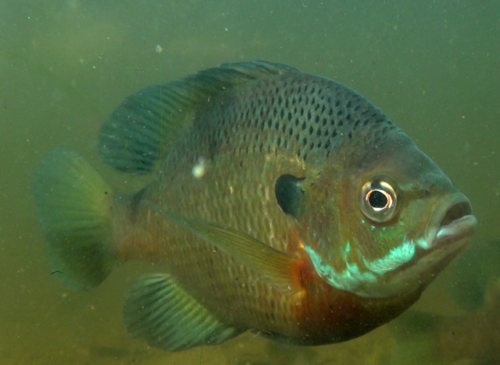
Bluegill
The Atlantic bluefin tuna (*Thunnus thynnus*) is a magnificent and highly migratory species of tuna renowned for its size, speed, and commercial value. As one of the largest bony fish, it plays a vital role in the marine ecosystem. This species has been prized for centuries, particularly in Japanese cuisine, leading to intense fishing pressure.
4 10 years
Lifespan
19 - 40 cm
Length
Least Concern
Conservation Status
15 km/h
Swimming speed
Insectivorous, Carnivorous
Diet
Local Migration
Migration
Appearance Overview
The Atlantic bluefin tuna is a large, streamlined fish with a metallic blue body and a silvery belly.
Color
Dark metallic blue on top, silvery-white underside
Body Shape
Torpedo-shaped, built for speed and endurance
Fins
Two dorsal fins, the first depressible; small, yellow finlets running from dorsal and anal fins to tail
Keels
Small keels present on the caudal peduncle
Length
Up to 13 feet (4 meters), commonly 6.5 feet (2 meters)
Weight
Up to 2,000 lbs (900 kg), commonly around 550 lbs (250 kg)
Diet
Carnivorous, feeding on a variety of fish (such as herring, mackerel, and hake), squid, crustaceans, and occasionally eel.
Feeding Behavior
Highly active predator, using speed and agility to chase down prey. They can hunt individually or cooperatively, sometimes herding prey into tight balls.
Social Behavior
Forms schools, especially when young. Schooling behavior can be size-dependent, with similarly sized fish grouping together. Adults can be solitary or form smaller, looser aggregations.
Commercial Relevance
Extremely high value, particularly in the sushi and sashimi markets. Individual fish can fetch tens of thousands or even hundreds of thousands of dollars.
Conservation measures
International fishing quotas, minimum size limits, time-area closures, and efforts to reduce bycatch. Some countries have implemented stricter domestic regulations.
Status
Endangered (IUCN)
Threats
Historical overfishing has severely depleted populations. Illegal and unreported fishing remains a significant threat. Bycatch in other fisheries and climate change also pose risks.
Habitat Distribution
Depth Range
Surface to 1,000 meters (3,300 feet), most commonly in the upper 200 meters (650 feet).
Geographic Range
Western and Eastern Atlantic Ocean, including the Mediterranean Sea. Historically, also present in the Black Sea.
Preferred Environment
Temperate and subtropical waters, preferring open ocean but sometimes venturing closer to shore, especially during spawning season.
Reproduction and Life Cycle
Breeding Habits
Spawns in two main areas: the Mediterranean Sea (primarily Balearic Islands area) and the Gulf of Mexico. Spawning occurs in warm waters, typically from May to July in the Mediterranean and April to June in the Gulf of Mexico.
Development Stages
Eggs are pelagic (free-floating). Larvae are planktonic and undergo rapid growth. Juveniles form schools and gradually develop the characteristics of adults.
Fecundity
Highly fecund; a large female can release up to 30 million eggs per spawning season.
Maturity Age
Matures at around 4-5 years in the Mediterranean and 8-12 years in the Gulf of Mexico.
Faqs about Bluegill
Where are Atlantic bluefin tuna found?
Atlantic bluefin tuna are found in the Atlantic Ocean, from the Mediterranean Sea to the Gulf of Mexico, and from Norway to the Canary Islands.
Are Atlantic bluefin tuna migratory?
Atlantic bluefin tuna are highly migratory, traveling long distances across the ocean for feeding and spawning.
Are bluefin tuna warm-blooded?
Yes, they are warm-blooded, which allows them to maintain a higher body temperature than the surrounding water, aiding in their speed and endurance.
What do bluefin tuna eat?
They primarily feed on fish, squid, and crustaceans.
How fast can bluefin tuna swim?
Bluefin tuna are among the fastest fish in the ocean, capable of reaching speeds up to 43 mph (70 km/h).
Copyright @ Nature Style Limited. All Rights Reserved.
 English
English